Gardening has always been a stress-relieving and enjoyable hobby. By putting in effort and time cultivating the right plants in your garden, you can expect your outdoor area to show off a vibrant mix of colorful flowering plants a couple of months after.
So, What's In It For You If You Cultivate a Garden?
Aside from improving the appeal of your lawn, you also get to do some physical exercise. And most importantly, horticulture has taken on a whole new level of importance in the society these days with the concept of edible garden.
Edible gardening is becoming a trend today because of the recent studies and news highlighting the carbon footprint of different food choices. As it turned out, growing fruits, vegetables, and other edible plants at home helps reduce carbon emission and prevent erosion. Growing organic produce is not only good for our health, but also for the environment! All you need to do is plan out how and where to plant your tomatoes, greens, beans, pepper, and berries. Then, you can shop and set up the right outdoor furniture, such as timber tables, lounges, and chairs, strategically in your yard in a way that will complement your elegant edible garden design and theme.

Must-Have Gardening Tools to Get Started
With all these wonderful ideas in mind, you might be wondering where and how to start creating an edible garden! Of course, that's not a problem. If you have a piece of lot to till already, all you need to do is equip yourself with the right tools. Specifically, make sure you have the following:
- Hand Trowel – You'll use this hand tool when you're potting, transplanting, and planting. When shopping for this item, make sure to find one with a comfortable grip and a stable connection between the handle and blade.
- Hoe – Hoes come in different types, such as the Scuffle hoe, Draw hoe, wheel hoe, and fork hoe. However, if you're into regular gardening, you can get a long way with a Draw or Dutch hoe. With this tool, you can do basic tasks like edging, cultivating the soil, weeding, and preparing plant beds.
- Pruning Shears –Also known as secateurs, this tool allows you to shape and trim shrubs and plants, as well as remove dead leaves and twigs. You might like to invest in a high-quality shear so that you can take on thicker branches.
- Fork and Spade – These tools are extremely useful when aerating the soil, removing weeds and stones, digging holes for seeds, mixing fertilisers, and creating plant bed divisions.
- Rake – This tool comes really handy if you're cultivating a stony ground. With a durable rake, you can get rid of stones and sweep up leaves to level and smoothen the soil surface.
- Saw - There are some plants and woody weeds that are just too thick for a pruning shear to cut and shape. Using a saw for these kinds of plants is the best way to go.
- Hori-Hori Digging Tool – Also called as the soil knife, this is a multi-purpose digging tool with a measuring device on the side of the blade that can be used when planting bulbs. This can also be used when weeding and cutting sod.
- Garden Hose – After setting up your yard and planting your choice of plants, the next thing to do is water the garden regularly. And you can't supply water efficiently without a garden hose with the right size and length. So when shopping for a garden hose, make sure to buy one that's long enough so that you can reach all areas of your yard.
- Wheelbarrow – Hand-carrying all your gardening tools and supplies is exhausting. You can solve this problem easily if you buy a wheelbarrow.
- Gardening Gloves – Let's face it. You're going to do a lot dirty work when gardening. But you don't have to ruin the beauty of your hands. Just shop for a pair of gardening gloves to protect your hands from direct contact with dirt and soil.
Effort, time, and patience are really required when gardening. If you're just getting started with horticulture, you don't actually need a lot of advanced tools. By securing the supplies and materials listed above, you can get started growing the right plants in your garden in no time.
